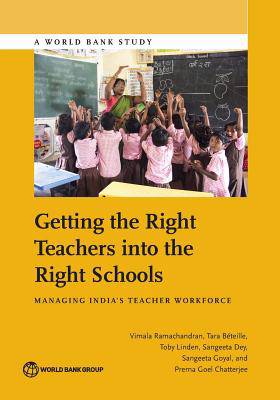
- Retrait gratuit dans votre magasin Club
- 7.000.000 titres dans notre catalogue
- Payer en toute sécurité
- Toujours un magasin près de chez vous
- Retrait gratuit dans votre magasin Club
- 7.000.0000 titres dans notre catalogue
- Payer en toute sécurité
- Toujours un magasin près de chez vous
Getting the Right Teachers Into the Right Schools
Managing India's Teacher Workforce
Vimala Ramachandran, Tara Beteille, Toby LindenDescription
India's landmark Right of Children to Free and Compulsory Education Act (2009) guarantees education to all children aged 6-14 years. The Act mandates specific student-teacher ratios and emphasizes teacher quality. Writing this into legislation took seven years, but the seven years since has proven that ensuring effective teachers are recruited and placed in all schools in a time-bound manner is considerably more challenging. This report takes a detailed look at the complexity of the teacher management landscape in elementary and secondary schools in nine Indian states. On a daily basis, the administrative machinery of these states has to manage between 19,000 to nearly a million teachers in different types of schools and employment contracts, and cope with recruiting thousands more and distributing them equitably across schools. This report examines the following issues: official requirements for becoming a schoolteacher in India; policies and processes for teacher recruitment, deployment and transfers; salaries and benefits of teachers; professional growth of teachers; and grievance redressal mechanisms for teachers. For the first time in India, this report compares and contrasts stated policy with actual practice in teacher management in the country, using a combination of primary and secondary data. In so doing, the report reveals the hidden challenges and the nature of problems faced by administrators in attempting to build an effective teacher workforce which serves the needs of all of India's 200 million school children. The report examines states with varying characteristics, thus generating knowledge and evidence likely to be of interest to policy makers and practitioners in a wide range of contexts.
Spécifications
Parties prenantes
- Auteur(s) :
- Editeur:
Contenu
- Nombre de pages :
- 290
- Langue:
- Anglais
- Collection :
Caractéristiques
- EAN:
- 9781464809873
- Date de parution :
- 15-11-17
- Format:
- Livre broché
- Format numérique:
- Trade paperback (VS)
- Dimensions :
- 178 mm x 254 mm
- Poids :
- 508 g

Les avis
Nous publions uniquement les avis qui respectent les conditions requises. Consultez nos conditions pour les avis.






